 W
WThe 11th Macedonian Infantry Division was a Bulgarian military unit formed by Macedonian Bulgarians that operated in the First World War. The division is the successor of the Macedonian-Adrianopolitan Volunteer Corps.
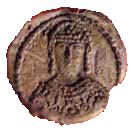 W
WThe Battle of Achelous or Acheloos, also known as the Battle of Anchialus, took place on 20 August 917, on the Achelous River near the Bulgarian Black Sea coast, close to the fortress Tuthom between Bulgarian and Byzantine forces. The Bulgarians obtained a decisive victory which not only secured the previous successes of Simeon I, but made him de facto ruler of the whole Balkan Peninsula, excluding the well-protected Byzantine capital Constantinople and the Peloponnese.
 W
WThe battle of Anchialus occurred in 763, near the town of Pomorie on the Bulgarian Black Sea Coast 42°33′N 27°39′E. The result was a Byzantine victory.
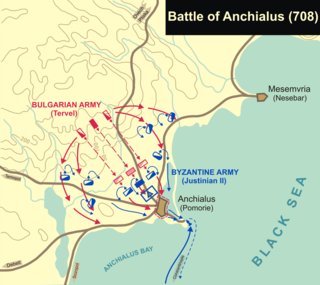 W
WThe Battle of Anchialus occurred in 708 AD near the modern-day town of Pomorie, Bulgaria 42°33′N 27°39′E.
 W
WThe Battle of Abritus, also known as the Battle of Forum Terebronii, occurred near Abritus in the Roman province of Moesia Inferior in the summer of 251. It was fought between the Romans and a federation of Gothic and Scythian tribesmen under the Gothic king Cniva. The Roman army of three legions was soundly defeated, and Roman emperors Decius and his son Herennius Etruscus were both killed in battle. They became the first Roman emperors to be killed by a foreign enemy. It was one of the worst defeats suffered by the Roman Empire against Germanics, rated by the Roman historian Ammianus Marcellinus as on par with the Battle of the Teutoburg Forest in 9 CE, the Marcomannic invasion of Roman Italy in 170, and the Battle of Adrianople in 378.
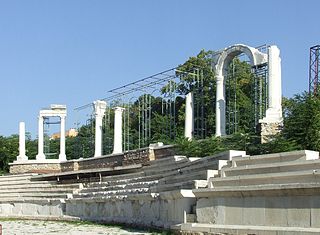 W
WThe Battle of Beroe was a conflict near Stara Zagora, ancient Ulpia Augusta Traiana, between the Romans and Goths in 250 which resulted in a Gothic Victory.
 W
WThe Battle of Beroia was fought in 1122 between the Pechenegs and the Byzantine Empire under Emperor John II Komnenos in what is now Bulgaria. The Byzantine army won the battle, resulting in the disappearance of the Pechenegs as a distinct, independent people.
 W
WThe Bulgarian Land Forces are the ground warfare branch of the Bulgarian Armed Forces. The Land Forces were established in 1878, when they were composed of anti-Ottoman militia (opalchentsi) and were the only branch of the Bulgarian military. The Land Forces are administered by the Ministry of Defence, previously known as the Ministry of War during the Kingdom of Bulgaria.
 W
WThe Bulgarian Legion was the name of two military bands formed by Bulgarian volunteers in the Serbian capital of Belgrade in the second part of the 19th century. Their ultimate goal was the liberation of the Bulgarian people from Ottoman rule through coordinated actions with the neighbouring Balkan countries.
 W
WThe Bulgarian People's Army was the military of the People's Republic of Bulgaria.
 W
WOpalchentsi were Bulgarian voluntary army units, who took part in the Russo-Turkish War of 1877–1878. The people in these units were called opalchenets-pobornik (опълченец-поборник) roughly meaning "folk-" or "regiment-combatant".
 W
WThe Battle of the Gates of Trajan was a battle between Byzantine and Bulgarian forces in the year 986.
 W
WThe Gorna Dzhumaya Uprising was an anti-Ottoman rebellion that broke out and spread throughout the Pirin region of Ottoman Macedonia in 1902. The uprising broke out on September 23, along the middle reaches of the Struma River in modern-day Bulgaria. It was poorly organized, premature and had a small scope. The uprising was held under the leadership of the Supreme Macedonian-Adrianople Committee (SMAC). The organizers were General Ivan Tsonchev and Stoyan Mihaylovski. The Internal Macedonian-Adrianople Revolutionary Organization (IMRO) disagreed with the SMAC plan and refused to take part in the fighting. The Bulgarian government also did not support the actions of the insurgents, because it was under strong international pressure. The Uprising was suppressed and ca. 2,000 refugees escaped to Bulgaria. With the appearance of the first refugees in many cities of the country, rallies were convened, which appealed to Europe and the Bulgarian government for intervention. The atrocities committed against the local population in the region provoked a reaction among the European public and it pressed the Sublime Porte for the adoption of some reforms. However, these reforms were not actually implemented.
 W
WIn an effort to reduce the fortress of Pleven quicker, Russian forces began targeting garrisons along the Ottoman supply and communications route. A significant garrison had been reduced at the Battle of Lovcha in September. General Joseph Vladimirovich Gourko was called up from the Shipka Pass area to deal with more of the garrisons protecting Pleven.
 W
W"Gotse Delchev" Brigade was a military unit composed of conscripts and volunteers from the region of Macedonia. The Brigade was named after the IMRO-revolutionary Gotse Delchev.
 W
WThe Battle of Kleidion took place on July 29, 1014, between the Byzantine Empire and the Bulgarian Empire. It was the culmination of the nearly half-century struggle between the Byzantine Emperor Basil II and the Bulgarian Emperor Samuel in the late 10th and early 11th centuries. The result was a decisive Byzantine victory.
 W
WThe Battle of Klokotnitsa occurred on 9 March 1230 near the village of Klokotnitsa. As a result, the Second Bulgarian Empire emerged once again as the most powerful state in South-Eastern Europe. Nevertheless Bulgarian power was soon to be contested and surpassed by the rising Empire of Nicaea.
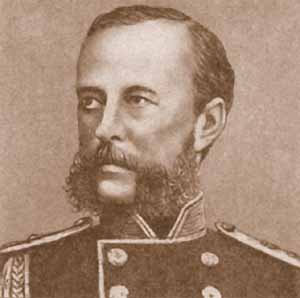 W
WThe Battle of Lovcha, or Loftcha, was a battle of the Russo-Turkish War (1877–1878) which occurred during the siege of Plevna. Russian forces successfully reduced the fortress at Lovcha, which had protected Plevna's communication and supply lines.
 W
WThe Siege of Lovech took place in the spring of 1187 between the forces of Bulgaria and the Byzantine Empire.
 W
WThe Macedonian-Adrianopolitan Volunteer Corps was a volunteer corps of the Bulgarian Army during the Balkan Wars. It was formed on 23 September 1912 and consisted of Bulgarian volunteers from Macedonia and Thrace, regions still under Ottoman rule, and thus not subject to Bulgarian military service.
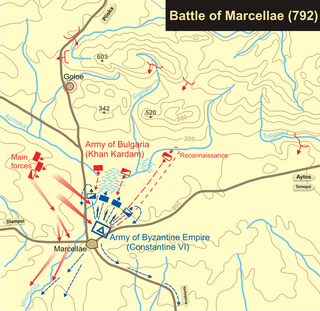 W
WThe Battle of Marcellae took place in 792 at Marcellae (Markeli), near the modern town of Karnobat in south eastern Bulgaria, the same site as an earlier battle in 756. The battle was between the forces of the Byzantine Empire, led by Constantine VI, and those of Bulgaria under Kardam. The Byzantines were routed and forced to retreat to Constantinople.
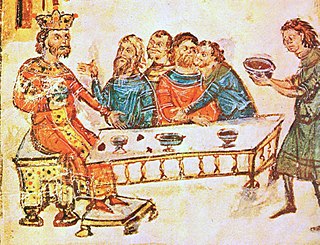 W
WThe medieval Bulgarian army was the primary military body of the First and the Second Bulgarian Empires. During the first decades after the foundation of the country, the army consisted of a Bulgar cavalry and a Slavic infantry. The core of the Bulgarian army was the heavy cavalry, which consisted of 12,000–30,000 heavily armed riders. At its height in the 9th and 10th centuries, it was one of the most formidable military forces in Europe and was feared by its enemies. There are several documented cases of Byzantine commanders abandoning an invasion because of a reluctance to confront the Bulgarian army on its home territory.
 W
WThe mobilization of the Bulgarian Army on the eve of the Kingdom of Bulgaria's entry into World War I took place between 11 and 30 September 1915. It was a direct consequence of the military convention between the German Empire, Austria-Hungary and Bulgaria and the Treaty of Friendship and Alliance between Bulgaria and Germany that were signed on 6 September, marking the official alignment of the country with the Central Powers.
 W
WDuring most of the Middle Ages the Bulgarians did not maintain naval forces. The first records of Bulgarians ships come from the reign of Khan Omurtag: during his war against the Franks (827-829) he came with ships from the Danube and landed troops in the rear of the Franks.
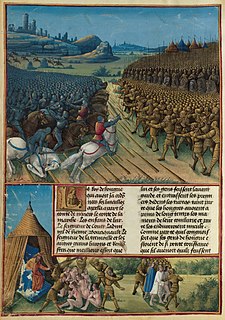 W
WThe Battle of Nicopolis took place on 25 September 1396 and resulted in the rout of an allied crusader army of Hungarian, Croatian, Bulgarian, Wallachian, French, Burgundian, German, and assorted troops at the hands of an Ottoman force, raising the siege of the Danubian fortress of Nicopolis and leading to the end of the Second Bulgarian Empire. It is often referred to as the Crusade of Nicopolis as it was one of the last large-scale Crusades of the Middle Ages, together with the Crusade of Varna in 1443–1444.
 W
WThe Battle of Nikopol, or Nicopolis, was one of the early battles of the Russo-Turkish War (1877–1878). As the Russian army crossed the Danube River, they approached the fortified city of Nikopol (Nicopolis). The Turkish high command sent Osman Pasha with the troops from Vidin to oppose the Russians' crossing of the Danube. Osman's intentions were to reinforce and defend Nikopol. However, the Russian IX Corps under General Nikolai Kridener reached the city and bombarded the garrison into submission before Osman could arrive. He instead fell back to Plevna. With the Nikopol garrison eliminated, the Russians were free to march on to Plevna.
 W
WThe Orange Guard was a Bulgarian paramilitary organization, belonging to the Bulgarian Agrarian National Union (BANU). It existed during the time that the agrarian leader Aleksandar Stamboliyski served as Prime Minister (1919-1923), both serving as his bodyguards and enacting the government's radical land reform policies. The militia was unofficially named the Orange Guard by the opposition, in reference to BANU's official color.
 W
WThe following is the Bulgarian order of battle at the beginning of the second phase of the First Balkan War as of January 21, 1913. This order of battle includes all combat units, including engineer and artillery units, but not medical, supply, signal and border guard units.
 W
WThe Battle of Philippopolis or Battle of Plovdiv took place on 30 June 1208 in the surroundings of Philippopolis between the armies of the Bulgarian Empire and the Latin Empire. The Crusaders were victorious.
 W
WThe Siege of Plevna, or Siege of Pleven, was a major battle of the Russo-Turkish War of 1877–1878, fought by the joint army of Russia and Romania against the Ottoman Empire. The Ottoman defense held up the main Russian advance southwards into Bulgaria for five months, encouraging other great powers actively to support the Ottoman cause. Eventually, superior Russian and Romanian numbers forced the garrison to capitulate. The Russian-Romanian victory on 10 December 1877 was decisive for the outcome of the war and the Liberation of Bulgaria.
 W
WThe Battle of Plovdiv, or Battle of Philippopolis, was one of the final battles of the 1877-1878 Russo-Turkish War.
 W
WThe Samara flag is one of the most important military symbols of the Bulgarian Army. Sewed by local nuns and given to the Bulgarian volunteers in the Russo-Turkish War of 1877-78 by the citizens of the Russian city of Samara on 18 May 1877, it became famous when it was heroically prevented from being captured by the Ottoman forces in the Battle of Stara Zagora, with many soldiers perishing while protecting it from the enemy.
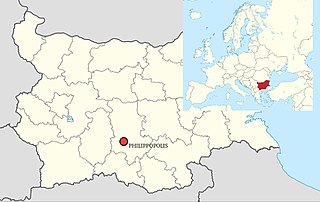 W
WThe Siege of Philippopolis was fought in about 250 between Rome and the Goths during the invasions of 249–253 at the Thracian city of Philippopolis, modern Plovdiv, Bulgaria. It was part of the long-running series of Gothic Wars.
 W
WThe Supreme Macedonian Committee chetas' action in 1895 was an armed expedition of several chetas from Bulgaria into the Ottoman-ruled Macedonia in the period of June-August 1895. Its aim was to provoke a general uprising in the area and to draw the attention of the Great Powers to non-compliance of the Treaty of Berlin (1878), and the provided reforms in European Turkey. The Supreme Macedonian Committee invited about 40 active and reserve officers from the Bulgarian army, as well as some old vojvodes from Macedonia. Among them were Boris Sarafov, Toma Davidov, Mihail Apostolov, Yordan Venedikov, etc. The number of the rebels was about 800 people, divided into four detachments. After invading Macedonia, the separate detachments headed to Strumica, Melnik and Dospat, respectively, but generally did not achieve much success. The failure of the action caused disagreements in the organization. The Ottoman government took advantage of the attack of the Pomaks populated Dospat and spread information about the atrocities in the European press. The Great Powers did not react as expected to the raising of the Macedonian question and instead of putting pressure on the Ottoman Empire, they put pressure on the Bulgarian government.
 W
WThe Battle of Svistov was a battle of the Russo-Turkish War of 1877–1878. It was fought between the Ottoman Empire and Imperial Russia on 26 June 1877. It occurred when Russian general Mikhail Ivanovich Dragomirov crossed the Danube River in a fleet of small boats and attacked the Turkish fortress. The next day, Mikhail Skobelev attacked, forcing the Turkish garrison to surrender. In result, the Russian military became ready to attack Nikopol.
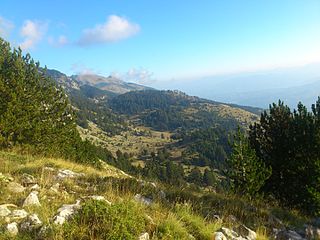 W
WTomornitsa is a medieval fortress located on a rock platform on the northwest slope of Mount Tomorr, hence its name. This is the last capital of the First Bulgarian Empire. Here, on 15 August 1018, after a 55-day failed siege, Ivats was blinded during fraudulent peace talks initiated by the Byzantines.